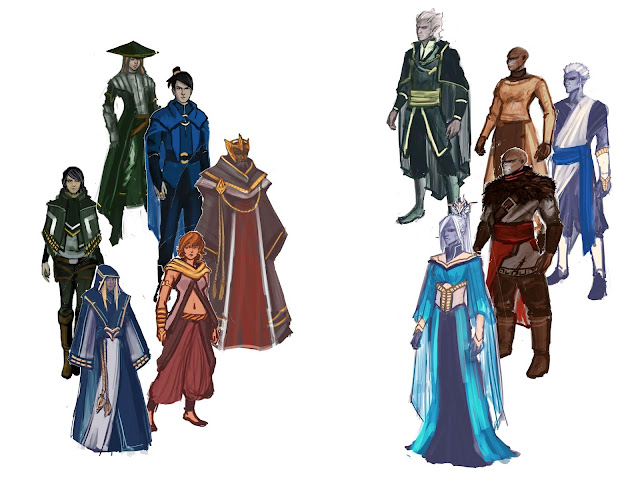The Brightest Shadow is a striking mix of epic and progression fantasy, blending the author’s love for wuxia and western fantasy into something wholly original.
There’s so much going on in the story that it’s hard to distill into a quick pitch, but I’ve found myself describing it as a wuxia twist on Stormlight that takes a more nuanced view toward different cultures. The comparison is hardly fair to either story—their primary similarity is an epic scope and complex world—but I think it accurately sets expectations for many fantasy readers.
I’ve lost count of the number of fantasy books I’ve read that involve large-scale war between two peoples. Usually, we get to see the beginnings of the war or get thrown into the thick of it. The Brightest Shadow begins instead with a race known as Deathspawn already having an established occupying force in human lands. And I should note that, in a twist we’re introduced to at the very start, “Deathspawn” is actually a slur the humans use for their oppressors. Their proper name is “mansthein” and they are at least as cultured and technologically developed as the humans.
We experience the story mostly through the eyes of several young humans from various cultures as they attempt to become more powerful and navigate the tense situation between mansthein and humans. While it feels like readers are meant to identify more with the human side of the conflict, things are far from a simple Good vs. Evil. If anything, the Big Bad of the story is the Legend, a story shared by all cultures that talks of a Hero rising to defeat the Dark Lord.

Sketches of various human and mansthein cultures, from The Brightest Shadow worldbuilding blog.
I don’t think I’ve seen this take on a prophecy before. It seems to have a mind and purpose of its own, and frequently results in large-scale destruction similar to a natural disaster. And while most of the cultures in the world are aware of the Legend, they all have a slightly different take on it.
My only previous experience with Sarah Lin’s work has been her New Game Minus trilogy, a LitRPG story where an NPC villain switches places with the human hero and has to learn how to navigate the leveling system of the mysterious “box gods.” The Brightest Shadow felt much more complex and consistent in its message, though it retains the cast of characters who approach everything logically and analytically. Where the LitRPG structure had characters getting power upgrades in discrete intervals, the sein wielders in this story learn through careful study, years of practice, and painfully slow progress toward mastery.
While I appreciated this approach, this is a looooong book. And I don’t just mean the 1200+ page count. As the first in a nine-book series, there is a lot of initial worldbuilding and character groundwork to cover. Each of the five parts in the book felt like a novel-length work of fantasy—because they were. But from a pacing perspective, I don’t think each part would work without the others. The core characters don’t have clear goals driving them every step of the way other than getting stronger, and memorable action only really occurs at the end of each part to transition into the next. For a story as long as The Brightest Shadow, this slow pacing can make for a daunting read.
That said, that’s often part of the Epic Fantasy genre that fans just have to expect when diving into a new world with this level of depth. And The Brightest Shadow takes the time to pay attention to the subtle worldbuilding details that make an invented world feel real and lived-in.
A significant amount of time is spent building out the various cultures of the world. I don’t just mean that the mansthein worship the Dark Lord—which, really? I can’t imagine belonging to a monotheistic religion that worships a malevolent god, but maybe that’s the point—and the humans have their own beliefs.
Everyone likes to tell stories about how horrible people are, far away from them…We tell plenty of stories about you that aren’t true. It’s a way of denying we’re the same.
We see cultures clashing in a multitude of ways. Some humans are disappointed to learn that the bread they love from their home is vastly different to the “bread” that makes up the staple food in another culture’s diet. Different people have different beliefs about the nature of sein and how to achieve mastery. Board games might have different rules from nation to nation, and so on. By the time I’d finished the book, it genuinely felt like there was a multitude of real cultures in the world.
As a final thought, I appreciated how battles were handled. By investing us in characters on all sides of the conflict, Lin deftly shows the horrors of war. With nearly every death, I felt a little sick inside. That random “monster” my favorite character just killed? He was struggling to support his wife and kids, had a wry sense of humor, and an adorable pet. There’s even “seinshock,” a magical analogue to PTSD. Violence is often portrayed as “fun” in fantasy. Not so here.
Overall, this was an original blending of genres and meticulously crafted story. I expect it to be somewhat divisive—the slow pacing adds to the initial learning curve found in sprawling epics, but those that push through to finish the story will likely be glad they did so.
I’m excited to see what’s next in the Brightest Shadow series, and I think Sarah Lin will be an author that epic fantasy and wuxia fans should look out for in the years to come.


Hey Travis, I really enjoyed the Brightest Shadow too, has the author mentioned it as a 9-book series? Wow that’s exciting